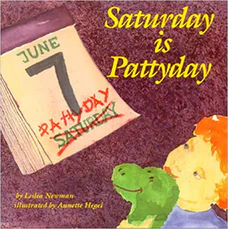Saturday Is Pattyday
Written by Lesléa Newman
Illustrated by Annette Hegel
24 pages
•
Published 1993 (New Victoria Publishers)

Recommended Age Range: Preschool through 2nd grade.
Publisher's Summary:
Although Frankie is hurt and confused when his two mommies separate, he is comforted by knowing that Patty will still be part of his life.

Dr. Annie's Takeaways
Recommended for: This book is an emotionally resonant story about a little boy whose two moms are getting divorced. One of his moms seems to have full custody (he sleeps at her house), and Frankie visits his other mom on Saturdays a.k.a. Pattydays. The story normalizes parental separation, validates feelings, and provides hope that children will stay close with both parents after a divorce, even if the custody arrangement is not 50/50.
Evidence-Based Practices:
Psychoeducation
Tone: Reassuring, emotionally evocative
Story Quality: This story weaves psychoeducation about divorce (e.g., “I still love you and I’m still your mom. Only grown-ups get divorced. Not kids”) into a story about a little boy whose mothers are newly separated. It’s a story with heart and authenticity, and even though it’s quite old at this point (it was written in 1993), it still holds up.
Illustrations: The illustrations are fine but the characters’ faces are a bit odd. The illustrations have a wiggly, abstract quality to them that works better on some pages than others. For some reason that has nothing to do with the plot, each two-page spread alternates between being in color and gray scale.
Representation: Frankie is a little boy who is White with red hair. He has two moms whom he calls by their first names–Allie and Patty. Allie has light-colored skin and black curly hair. Patty is White with short brown hair. The story starts by Patty moving out of the family’s house and into a separate apartment. Allie seems to have full custody, but Frankie spends Saturdays with Patty (Pattydays), and there is a pull-out couch there that he can sleep on when he spends the night. The parents’ separation is referred to as a divorce.
Psychological Practices: This story validates how scary it can be to hear parents fighting, and it normalizes a child’s feelings of missing a parent after a parents’ separation. There is a scene that involves Frankie getting angry with Patty for bringing an apple on their picnic rather than an orange, and then crying because he’s afraid they’re going to get divorced since they are fighting. This strikes me as a realistic scene–kids often get angry about little things when deep down they are scared of big things. Patty clarifies that she and Allie will always be Frankie’s moms and that kids and parents don’t get divorced. This book presents a model of two loving, involved parents, even though Frankie seems to be living full-time with Allie.
Concerns: There are two mentions of Patty sounding/looking sad, and Frankie cheering her up (e.g., by leaving his beloved stuffed dinosaur Doris Delores Brontosaurus with her). I appreciate the acknowledgement that children often notice their parents seeming sad after a separation or divorce, and the things Frankie does to take care of Patty likely help him to cope with the changes too. That said, it shouldn’t ever be a child’s job to take care of a parent’s feelings in a situation like this, and I would want to make sure a child understands this.
